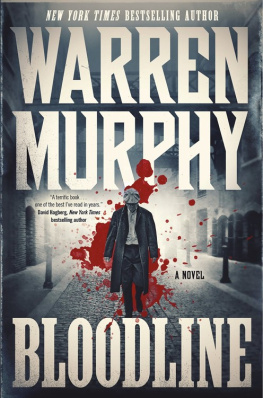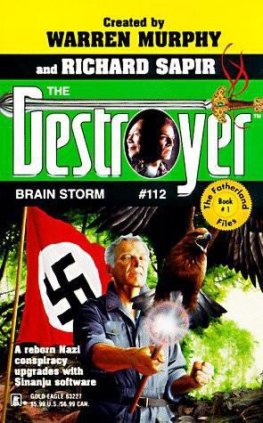Bidding War
By
Warren Murphy & Richard Sapir
First edition November 1995
ISBN 0-373-63216-9
Special thanks and acknowledgment to
Will Murray for his contribution to this work.
BIDDING WAR
Copyright 1995 by M. C. Murphy.
All characters in this book have no existence outside the imagination of the author and have no relation whatsoever to anyone bearing the same name or names. They are not even distantly inspired by any individual known or unknown to the author, and all incident are pure invention.
Printed in USA
For James E. Malone, Prince of
Home Renovation
And for the Glorious House of Sinanju,
P.O. Box 2505, Quincy, MA 02269
[willray@cambridge.village.com]
Chapter One
For Dr. Harold W. Smith, the tension began building when his battered station wagon approached the span of the Triborough Bridge.
It began as a knot in his acidy stomach that tightened with each rattle of the bridge deck plates. He popped an antacid tablet dry, let it settle, then popped two more.
Smith hated Manhattan traffic. But the late-afternoon congestion was the least of his concerns. When he eased off the foot of the bridge and rolled into Spanish Harlem, he began to feel queasy. The lemony expression on his pinched and patrician face soured even more than normal.
He shot up East 125th Street and turned left onto Malcolm X Boulevard. He was in Harlem now. It had been a year since he had last been to Harlem, when he had nearly lost his life.
During World War II, Harold Smith had operated behind enemy lines, later serving with anonymous distinction in the early days of the Cold War. In those days they called him the Gray Ghost. That was before the years had grayed his hair. His skin was gray in those days. It was a darker gray now. A congenital heart defect was responsible. He wore the same style three-piece gray suit that had been his daily uniform during his CIA days. He had worn one just like it on his wedding day. It had been written into his will that he be buried in a gray three-piece suit.
But as he sought a parking space, Smith didn't feel like the Gray Ghost. He felt like an old white man in Harlem. At risk.
A space opened up near Mount Morris Park. It wasn't close enough to the XL SysCorp Building that reared up four blocks south. So Smith drove on.
As soon as Smith saw the alley, he remembered it. He had parked there last time, and it was there that a street thug had tried to steal his van. He pulled in. Last time it had been night. Now it was broad daylight. How dangerous could Harlem be in broad daylight? he reasoned.
But he knew the truth. It was as dangerous as any major American city could be these days. Which was very, very dangerous indeed.
Setting the parking brake, Smith let his gray gaze go to the twenty-story XL SysCorp Building. It had been a blade of blue glass a year ago. It was still blue. Where glass once gleamed, plywood sheets covered many of the windows. Others had been shattered by vandalism and stray gunshots.
The newspapers had dubbed it the first crack skyscraper in human history. Decent people shunned it. No one would buy it. The police were afraid to enter.
Harold Smith had no intention of entering the abandoned building. He just needed to spend a few minutes in the alley adjoining it.
For a moment Smith debated leaving his worn leather briefcase in the car. Its contents were too valuable to risk their theft on the street. On second thought, leaving the briefcase on the seat might invite a brick through the window glass. A crack-head, Smith knew, was capable of stealing anything, valuable or not. And a station wagon wouldn't fight to retain possession. Harold Smith would.
He left the car with the case clutched tightly in one white-knuckled hand. Inside was his portable-computer link and a satellite telephone. In an emergency he could call 911 with it. If there was time.
Smith walked briskly to the alley, ignoring a three-card-monte game going on at the corner and a jeering invitation from the scruffy dealer to try his luck.
The alley was a concrete apron jammed between XL SysCorp and the next building, where pages from yesterday's Daily News swirled and made sounds on the concrete like finger bones scraping along pavement.
There was a patch of asphalt on the concrete, just as Smith had known there would be. He went to it, eyes sweeping the area warily.
People passing on the street glanced at him. One or two did a double take, but no one bothered him. Smith began to relax.
According to his computer search, the patch of tar had been laid to seal the installation of new phone lines to the XL building back when it was on the cutting edge of the information age and not a refuge for drug users. Such repairs and upgrades were performed all the time.
What brought Harold Smith to Harlem was the logged date of the repairs, September 1 of last year. The same date on which Smith had lost his dedicated telephone line to Washington, D.C.
It was no coincidence. Could be no coincidence. It was too pat. On September 1 an enemy more calculating than any human foe had launched a multi-pronged attack on CURE, the supersecret organization headed by Harold W. Smith. The attack had stripped him of his funding, his enforcement arm and the secret line to the Oval Office.
Smith had swung into action and carried the fight to XL SysCorp, bringing the source of the threat to its knees. Figuratively speaking. The foe had no knees. Or hands. It was an artificial intelligence, housed in a single computer chip. Designed to perform one single-minded functionto make a profitit had plagued the world economy on three occasions. The first two times CURE had stopped it. On the third time the chipit was called, for some reason, Friendhad decided to neutralize CURE before implementing its latest profit-making scheme. But Harold Smith had tracked Friend to its high-tech lair and forced it out of businessthat time, he hoped, forever.
In the months that followed that midnight victory, Smith had methodically reconstituted CURE, restoring all but the dedicated hot line. Smith knew that somewhere along the buried cable pipe a break had been made, severing the multiline connection and its numerous redundant lines. The cable should have lasted for a century. It had already served Smith through three decades and eight administrations. But a five-hundred-mile buried cable was almost impossible to police since it existed on no AT&T cable maps and officially did not exist at all, any more than CURE itself existed.
In the privacy of his office at Folcroft Sanitarium in Rye, New York, where he ran CURE under the guise of a private hospital, Smith had grappled with the problem of restoring the CURE line for a solid year.
How had Friend accessed the cable? And at what point?
Months of fruitless searching and thinking had accomplished little except forcing Smith to think along unconventional lines. Only sheer desperation prompted him to investigate telephone company repair logs on or about September 1 in a Sumner Line plot from Rye to Washington, D.C.
The logs indicated numerous repairs. As he sifted through them, one in particular caught Smith's eye. At first he thought his discovery that NYNEX had repaired a line on Malcolm X Boulevard beside the XL SysCorp Building was too convenient, too pat.
Then Smith remembered Friend had once had access to CURE'S innermost computer secrets and would know the exact path of the dedicated line to the President. The more Smith considered it, the more plausible it seemed. It wasn't impossible, he realized, that Friend had chosen this site on which to erect his XL SysCorps headquarters precisely to access the CURE hot line. As an artificial intelligence, Friend would logically make decisions based on multiple options and advantages.
Next page



